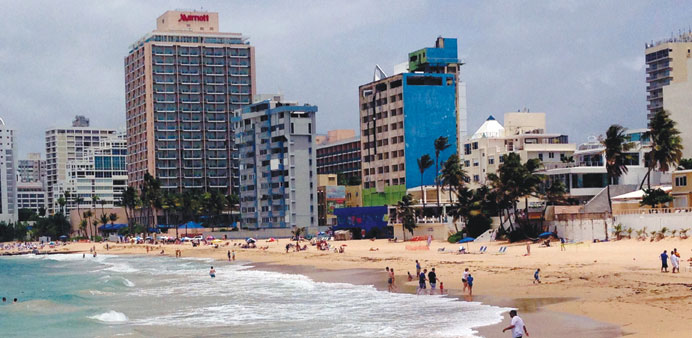By Anne Krueger/Washington
Puerto Rico ought to be the jewel of the Caribbean. It is not. Tourism has been stagnant for decades, even as travellers have flocked to other Caribbean destinations. European firms doing business in North and South America locate their corporate headquarters in Miami, Panama City, and elsewhere, with almost none choosing Puerto Rico.
And now the island’s economy, after a decade of torpor, is declining at an accelerating rate as people leave for the US mainland. Public debt has soared, and the government says it cannot pay.
Unlike Greece, Puerto Rico is not a country (which means that it is not eligible for financing from the International Monetary Fund). Nor is it a US state. Yet it has features of both: Although it has its own constitution, it is a US territory, Puerto Ricans are US citizens, and the island is subject to US federal law, except as otherwise stipulated.
The advantages of this hybrid status include the security and predictability of America’s rule of law, eligibility for federal transfer payments, and favourable tax treatment. Puerto Ricans who are not US government employees do not pay federal income tax, and the island’s bonds are “triple tax-exempt” (free of federal, state, and local taxes).
But there are also disadvantages to this arrangement. For example, Puerto Rico is subject to the Jones Act, which requires using very costly US-built ships and crews for all sea transport to and from the mainland. The island must also comply with the federally mandated minimum wage, despite an income level about half that of the poorest US state. And municipalities cannot benefit from Chapter 9 of the US bankruptcy code.
Puerto Rico’s current troubles trace their origin to the gradual withdrawal, starting in 1996, of earlier exemptions from US corporate taxes for companies located on the island. Capital-intensive companies, especially pharmaceutical firms, began leaving. Puerto Rico’s economy recorded little growth after 1996, and real (inflation-adjusted) GDP has been falling for the past decade.
Many Puerto Ricans, unable to find jobs on the island, have migrated to the mainland, with the population and labour force estimated to be shrinking at a rate of 1.5% this year. Moreover, Puerto Rico’s labor force participation rate is under 40%, compared to 62% on the mainland.
There is plenty of blame to go around for these failures. Puerto Rico and the US government each bear responsibility.
Successive Puerto Rican governments thought that the island’s economy was in “recession” and attempted to spur activity by increasing government spending. Low interest rates meant that deficits could be financed by floating bonds. Debt mounted, and markets are now almost entirely closed to more.
Despite efforts to cut expenditures and boost tax receipts, current and prospective obligations (including pension liabilities) far exceed any feasible increase in government revenues. Given the ease with which Puerto Ricans move to the mainland, raising taxes is unlikely to increase revenues.
The US government also is culpable. The inapplicability of Chapter 9 makes orderly debt restructuring very difficult. Moreover, Puerto Rico is covered by the Patient Protection and Affordable Care Act and must pay accordingly, even though the island’s doctors are compensated at a lower rate than those on the mainland (and the Puerto Rican government must bear much of the cost). The same is true of some other welfare payments.
Low labour force participation is a result of the relatively low productivity of Puerto Rico’s unskilled workers. Companies cannot compete with firms that pay much lower wage rates on neighboring islands. A rule of thumb is that a minimum wage that is above 55% of the median wage will impede job creation (and economic growth); Puerto Rico’s minimum wage is 77% of the median, owing to the federal mandate.
A family of three with one wage earner at the minimum wage can take home about $1,100 per month, while it could get about $1,700 on welfare. No surprise, then, that people either leave the island or go on welfare and work in the informal economy.
Overcoming Puerto Rico’s crisis will require restoring growth, implementing a sustainable fiscal policy and debt restructuring. Accomplishing the first of these would, together with reduction of excessive government expenditures, help to achieve the second.
For the Puerto Rican authorities, this means making the island friendlier to business, including by removing onerous labour-market regulations. Meanwhile, the US government could exempt Puerto Rico from the Jones Act, extend to it Chapter 9 bankruptcy coverage, and align the island’s welfare and labour requirements with its productivity level.
Each of these policy actions requires political will. Puerto Rico’s governor, Alejandro Garcia Padilla, has appointed a working group to produce a five-year programme to restore growth and fiscal sustainability. Bills to make Puerto Rico eligible for Chapter 9 are being introduced in Congress.
These and other measures now under consideration promise to improve Puerto Rico’s economic prospects. But they will require concerted and determined action on all fronts.
Puerto Rico is not Greece; successive governors of the island have introduced budgets they thought were balanced, only to find that inadequate growth led to lower revenues and higher expenditures than had been projected. But it is a US territory. The US government should do its part to improve the island’s prospects.- Project Syndicate
- Anne Krueger, a former World Bank chief economist and former first deputy managing director of the International Monetary Fund, is professor of International Economics at the School of Advanced International Studies, Johns Hopkins University, and Senior Fellow at the Centre for International Development, Stanford University.

Beach-goers enjoying the surf in San Juan, Puerto Rico’s capital. But tourism has been stagnant in Puerto Rico for decades, even as travellers have fl


